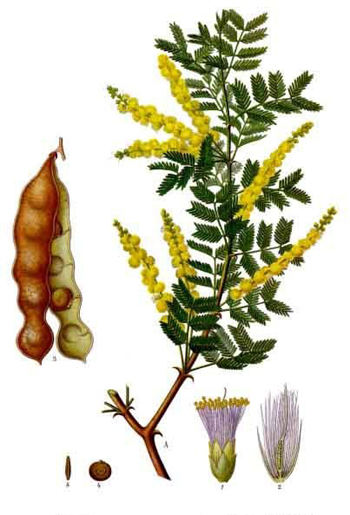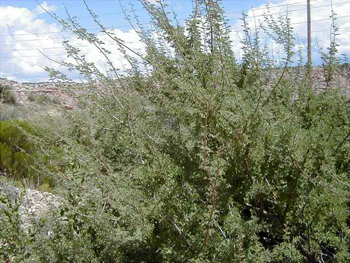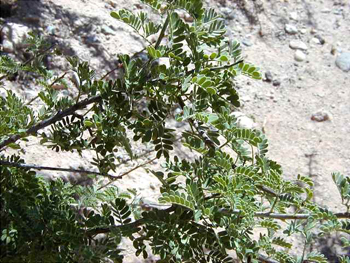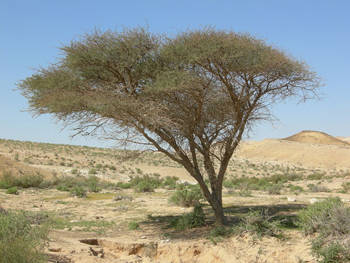Contents:
Common Names | Parts Usually Used | Plant(s) & Culture | Where Found | Medicinal Properties
Legends, Myths and Stories | Uses | Formulas or Dosages | Resource Links | Bibliography
Scientific Names

Acacia Senegal |
- Acacia senegal L.
- Acacia greggii
- Mimosa family
- Fabaceae family
Common Names
- Cape gum
- Egyptian thorn
- Gum Arabic tree
- Gum acacia
- Gum Arabic
- India gum tree
- Bablah pods
- Acacia bambolah
- Catclaw
- Cat’s Claw
- Tear Blanket
- Uña de gato (Spanish name)
- Devils claw
- Paradise flower
- Long-flowered catclaw
Parts Usually Used
Gum
Back to Top
Description of Plant(s) and Culture

Acacia Greggii Bush |
Acacia is a small, spiny, leguminous tree or shrub. After the rainy season ends, the stem begins to exude gum, which is collected from December to June for marketing as gum Arabic. The acacia has alternate, bipinnate leaves and axillary racemes of yellow flowers arranged in globose heads. The fruit is an oblong pod.
There are literally dozens of species of acacia, worldwide. Their descriptions and usefulness varies greatly. Be sure to get the advice of a knowledgeable herbalist before using acacia.
Back to Top
Where Found

Acacia Greggii Leaves |
Acacia senegal L.: Grows in sandy soil, mostly in tropical Africa
Acacia greggii: a member of the Fabaceae family; it is native to the Southwestern United States and northern Mexico.
Back to Top
Medicinal Properties
Demulcent, mucilaginous, antiviral
Back to Top
Legends, Myths and Stories

Acacia Negev Tree, Israel |
Acacia was a sacred wood for the ancient Hebrews. Moses used acacia wood in building the Ark of the Covenant and the sacred Tabernacle (see Exodus, chapters
According to Near-Eastern Christian legend, a thorny species of acacia was used for Christ’s crown of thorns.
Moapa Paiute name for acacia is “Pah oh pimb.” Used for inflammation of the eyes, due to dust; vaqueros and travelers habitually carry acacia seeds and put 4 in each eye on retiring.
Back to Top
Uses
Gum Arabic’s main effect is to form a protective, soothing coating over inflammations in the respiratory, alimentary, and urinary tracts. It is helpful for coughs, sore throat, and catarrh, eyewash, diarrhea, and dysentery. Sweetened, it is sometimes used for typhoid fever.
Back to Top
Formulas or Dosages
Gum Arabic is usually dissolved in water to make a mucilage.
Mucilage: a dose is from
Syrup: mix 1 part mucilage with 3 parts of a syrup. A dose is from
Back to Top
Resource Links
LiveStrong.com: Acacia for Medicinal Uses
Medicinal Plants of the Southwest (US): Acacia
Purdue University, Horticulture: Acacia
Bibliography
 Back to Eden
Back to Eden, by Jethro Kloss; Back to Eden Publishing Co., Loma Linda, CA 92354, Original copyright 1939, revised edition 1994
 Indian Uses of Native Plants
Indian Uses of Native Plants, by Edith Van Allen Murphey, Meyerbooks, publisher, PO Box 427, Glenwood, Illinois 60425, copyright 1958, print 1990
 The Herb Book
The Herb Book, by John Lust, Bantam Books, 666 Fifth Avenue, New York, NY. copyright 1974.
 Webster’s New World Dictionary
Webster’s New World Dictionary, Third College Edition, Victoria Neufeldt, Editor in Chief, New World Dictionaries: A Division of Simon & Schuster, Inc., 15 Columbus Circle, New York, NY 10023
